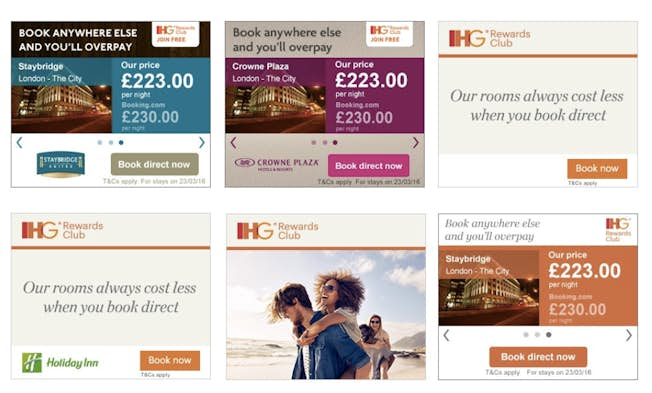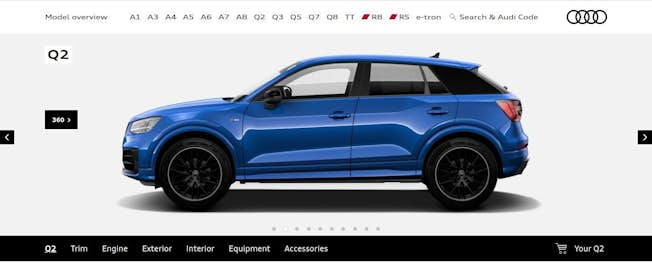Oct 12, 2021
The Beginner’s Guide to Programmatic Advertising
If you or your business use online advertising, you may have heard people rave about how programmatic ads and the Internet of Things is disrupting digital marketing.
Your ad could be brilliant, but if it’s not in the right place targeted at the right people, then your campaign will never reach its true potential. So if you nod when people claim programmatic advertising is a game-changer but not understood why, you’re in luck.
In this article, we break down what programmatic advertising is, explain targeting best practices and examine four brands that are doing it right.
What is programmatic advertising?
Programmatic ad buying is the use of software to buy digital advertising. While the traditional method includes requests for proposals, tenders, quotes, and negotiation, programmatic buying uses algorithmic software to buy and sell online display space.
A sophisticated way to place advertising, it uses traffic data and online display targeting to drive impressions at scale which results in a better ROI for marketers. It can also yield great results for both SMEs and global brands so don’t ignore it just because your organization is small.
However, it’s not the complete automation of the ad buying process. Traditionally, you manually prepare insertion orders or ad tags, which can be labor-intensive. With programmatic advertising, marketers have more time for the optimization and improvement of ads to drive campaign success.
What are programmatic advertising platforms and tools?
Programmatic advertising is a powerful tool and global spend in 2020 topped $129 billion and is expected to surpass $150 billion in 2021. The United States is the biggest spender on programmatic ads, but the UK and China are catching up fast.
How and why is programmatic advertising successful?
Quite simply: yes, it is successful because it’s efficient, targeted, and scalable.
Just two years ago, spend by US marketers on programmatic ads was over $61 billion. In 2023, that figure is projected to rise to $133 billion which is 91% of total digital ad spend.

This growth has blown previous projections out of the water according to eMarketer and is largely down to a rapid recovery in the area after the COVID-19 pandemic and evolution in Artificial Intelligence and how it is changing marketing.
The system works and is used because it is an efficient use of both time and resources.
As John Lincoln, CEO and founder of SEO company Ignite Visibility explained why programmatic advertising is the hottest new digital marketing trend:
Programmatic advertising is designed to do away with old-fashioned, hit-or-miss campaign design. That system was notorious for costing marketers way too much money."
Now, with programmatic advertising, you can rely on an algorithm that will determine where your ad money is best spent. All you have to do is feed your programmatic solution information about your campaign, audience, and key performance indicators, and the algorithm will do the hard work!
“The system will not only launch your campaign, but it will also monitor your ad spend to look for areas of improvement,” stated Lincoln.
If you’re looking to optimize ad spend, boost your organization’s ROI, and resonate with your target audience, programmatic advertising has the potential to help you thrive.
How can you succeed with programmatic advertising?
Now that we’ve established the benefits of programmatic advertising, let’s explore how you can use it to your advantage in digital marketing campaigns.
1. Know your marketplace
This first point is pretty simple: figure out what’s involved by doing some research. As a marketer venturing into a new area of advertising, you will encounter many new ideas and terms, so take the time to get to know them.
Check out this comprehensive list of programmatic advertising terms that will give you an understanding so you can tell your SSP from your DSP.
2. Set your programmatic advertising goals
As with anything in digital marketing, it’s important to have your goals set from the start. To do this, you should use existing data to determine the type of advertising awareness you need and build an effective strategy that will help you to determine short- and long-term goals.
3. Keep the human touch in mind
Just because programmatic advertising relies on algorithms and machines, that doesn’t mean it is devoid of a human touch. There are different platform types, some of which offer fully or half-managed services such as War Room. Others provide technical platforms like Digilant, that allow you to run your programmatic buying activities.
From there, you will need to allocate skilled marketers to plan, control, and optimize your buying. Ultimately to enjoy optimum success, you will need to find the perfect marriage between automation and intelligent human intervention. So don’t rely on the algorithm alone to yield the best results for your campaign.
4. Protect your brand from fake news
As discussed, one challenge of programmatic is that its reliance on algorithms can lead to ads appearing in the wrong place such as sites that promote fake news like coronavirus conspiracy theories
To avoid this, ensure that your demand-side blacklist is constantly updated and monitored for inappropriate sites. Some platforms allow for the exclusion of entire categories from ad spends, which can be particularly helpful.
Another option, which is important if your product is sensitive, is to use a whitelist. This will give a list of approved (rather than denied) sites. It will narrow your ability to reach your audience and possibly make it more expensive, but it will ensure no explicit or offensive material is associated with your ad.
If you use an agency, ensure they do all they can to exclude low quality and sensitive sites from having your ads served on them.
5. Watch for programmatic ad fraud
Typically, programmatic ads are viewable between 44% and 55%, but eMarketer estimates fraud will cost digital advertisers from $6.5 billion to $19 billion each year. Consumer privacy is also an issue for advertisers especially on mobile and Connected TV (CTV).
So how can your business deal with fraud? The first thing to do is look at budget vs. reach. Marketers have been fixated on reach when it comes to programmatic advertising which can leave campaigns open to abuse through bots. If a deal looks too good to be true when bidding for ad space, then it probably is! Try not to fixate on reach but couple it with traffic quality to avoid generating fake traffic.
Another thing your organization can do is ensure ads are compliant with privacy regulations. According to Pixalate, 22% of Apple App Stores and 9% of Google’s have apps that do not have a privacy policy which can lead to ‘dangerous permissions’. Avoid being one of those brands.
What are good examples of programmatic advertising? campaigns
These real-world examples of programmatic advertising demonstrate the power of this cutting-edge promotional medium in action.
Missing People - Child Rescue Alert

The charity Child Rescue Alert moved to programmatic ads in 2016 in response to a lack of financial resources to “save lives”.
The move to programmatic allowed the charity to move from issuing one targeted appeal ad a week to targeting users by the areas in which children have gone missing.
Director of Funding Ross Miller said: “When we first started using out-of-home (outdoor advertising), 50% of children we appealed for were found alive, when we switched to a more programmatic use of out-of-home our response rate went to 70%. People respond to a message that is relevant to either where they live or a location.”
The Economist

The Economist’s award-winning campaign saw a huge return on investment.
Using the publication’s content along with provoking, witty or humorous headlines, the ads were able to target intellectually curious readers whose cookies showed they hadn’t spent much time on the Economist’s website.
The results were impressive. According to eConsultancy they generated 650,000 new prospects, prompted 3.6m into taking action and a campaign ROI of 10:1 on a £1.2m media budget.
This was coupled with a jump in awareness in the US of 64% and consideration rose by 22% - an incredible achievement in anyone’s book.
IHG

Hotel group IHG, the parent company that owns the Holiday Inn and Intercontinental chains, began running programmatic ads to encourage users to book directly with them, rather than with third-party sites like Expedia or Booking.com.
In the travel industry, third-party sites can take commissions of between 15% and 24%, so direct spend can make a huge difference to hotels.
IHG’s programmatic ads targeted consumers who were thinking of making a reservation with an ad including a `book direct price’ option.
As COO Matt Luscombe told Marketing Week, the campaign was a major success.
"By using advanced targeting capabilities through programmatic, we are able to find a broader range of people looking for accommodation and target them with our book-direct message. Buying lots of banners online just didn’t have any effect except for surge marketing, which has been tremendously effective."
Luscombe says that IHG’s plan was a shot in the arm for hotel brands.
“The hotel industry has now woken up,” said Luscombe, who claimed other hotel brands including Hilton and Marriott are now following his company’s lead.
Audi

To prepare for the launch of its customizable vehicle, world-renowned automotive brand Audi set itself the aim of further personalizing its marketing efforts and crafting a campaign that lived up to its iconic slogan, ‘Vorsprung durch Technik’ (‘Advancement through Technology’).
Working in close collaboration with Google using display and Video 360, Audi took a data-driven approach that combined all customer data rather than relying on siloed information. That way, by using programmatic techniques the marketing team could optimize its most valuable consumer touchpoints.
In addition to capturing behavioral data for improved marketing segmentation, the brand offered users the chance to customize their dream car online from a choice of 6,000 possible combinations. These individual designs were then used to create personalized dynamic ads that resulted in double the efficiency of standard ads. While buying programmatic ads resulted in a conversion rate four times higher than ads bought through traditional methods.
By buying ads programmatically it is possible to enjoy an average conversion rate of four times higher than those purchased using traditional methods: and Audi is a testament to that very notion.
These campaigns demonstrate the power of programmatic advertising to target the right customers at the right time to achieve meaningful engagement and measurable conversions. While many marketers find programmatic confusing and complicated, it’s a simple and scalable process once you get the hang of it. The secret? Knowing what you’re doing and why!
Supercharge your programmatic ads with a search marketing course
With DMI’s certified search marketing course, you will dive into SEO, paid search (PPC), Google AdWords, Microsoft Ads and digital display advertising. Get the skills, knowledge, techniques and strategy know-how to create digital advertising campaigns that engage, influence and convert.
First published January 2020, Updated October 2021
Related
Upgrade to Power Membership to continue
your access to thousands of articles, toolkits, podcasts, lessons and much much more.
Become a Power Member- Login
- View Courses
- - - -
- Courses
- Resources
- - - -
- My Account
- Change Password
- Logout





